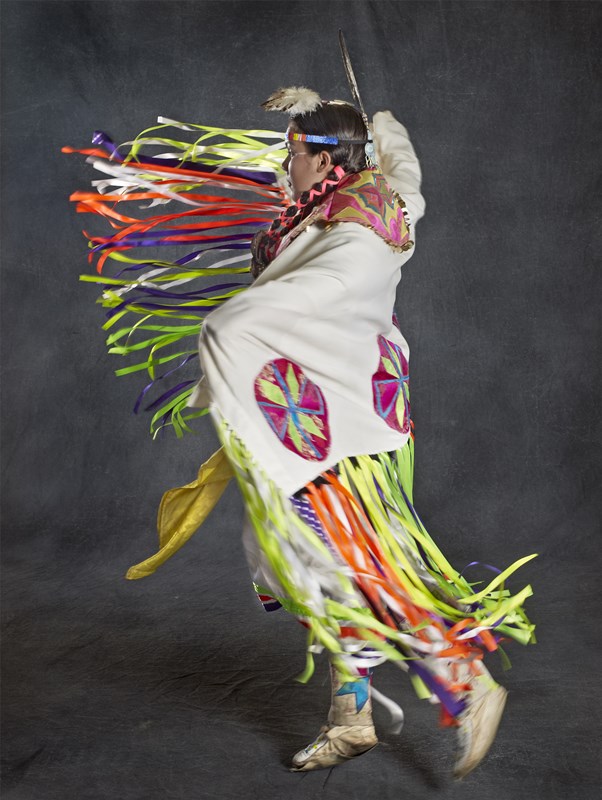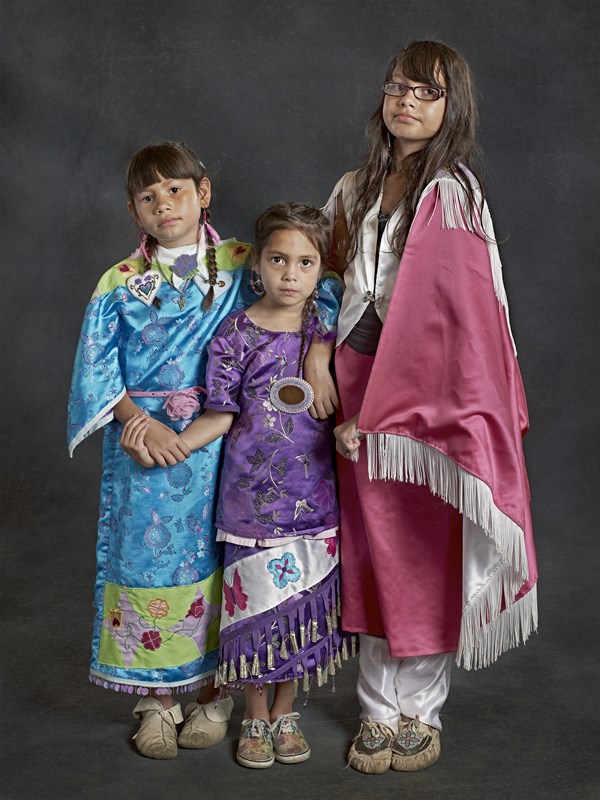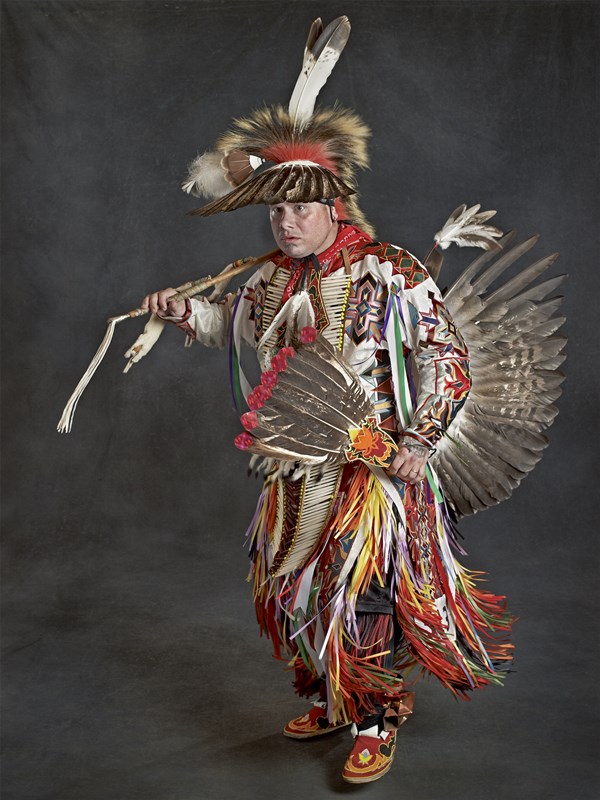Chicago’s Sharon Hoogstraten is a tribal member of the Citizen Potawatomi Nation. She also has forged a stellar career as a photographer, filmmaker, and Emmy award-winning graphic designer and animator. (See second photo at right.)
Now she brings her latest stunning project to Skokie.
In 2010 she was invited to exhibit her photography at the annual Potawatomi Family Reunion Festival in Shawnee, Oklahoma. There, she proposed to make formal portraits of Nation members in dance regalia. The project was so successful that she eventually expanded it to the nine geographically scattered Potawatomi nations, in Oklahoma, Kansas, Wisconsin, Michigan and Ontario.
The result of Hoogstraten’s decade-long project is an epic 304-page book entitled Dancing for Our Tribe: Potawatomi Tradition in the New Millennium. The book features splendid portraits of tribe members in their dance regalia, as well as compelling handwritten reflections of each person who posed.
In addition to her two-month photo exhibit set to run here at the Skokie Heritage Museum and at the Devonshire Cultural Center, Hoogstraten’s work has also been featured at the Smithsonian Institute’s National Museum of the American Indian, at the State Museum of Illinois, and at the Kroc Institute at Notre Dame.
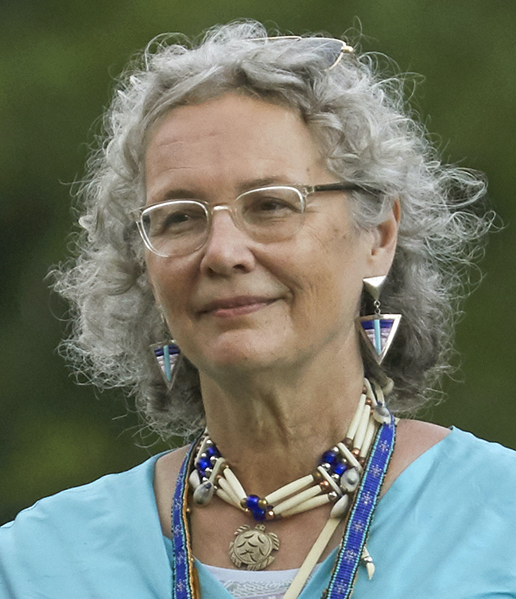 Regarding the project she said, “In the last ten years of photographing and listening to personal stories, it is regalia that forms the basis of my cultural exploration. Through my portraits, I know these Potawatomi descendants are living modern lives, while reflecting deeply on the ancestors whose footsteps we tread on. They are not wearing ‘costumes’ and unlike street clothes, each dancer knows exactly where their clothing comes from and what it means.”
Regarding the project she said, “In the last ten years of photographing and listening to personal stories, it is regalia that forms the basis of my cultural exploration. Through my portraits, I know these Potawatomi descendants are living modern lives, while reflecting deeply on the ancestors whose footsteps we tread on. They are not wearing ‘costumes’ and unlike street clothes, each dancer knows exactly where their clothing comes from and what it means.”
“Photographing formally on a seamless sweep using studio lighting, I stripped away all distractions, maximized detail, and also created a look reminiscent of the Indian Country studio portraits of a century ago. We peer into portraits past and present looking for details of culture, but even more compulsively, for clues about that particular human being. I strived for that honest, revealing, enduring revelation of each individual I photographed – sometimes conveyed in stillness, or by a delayed recognition of motion, ranging to outright exuberant dance.”
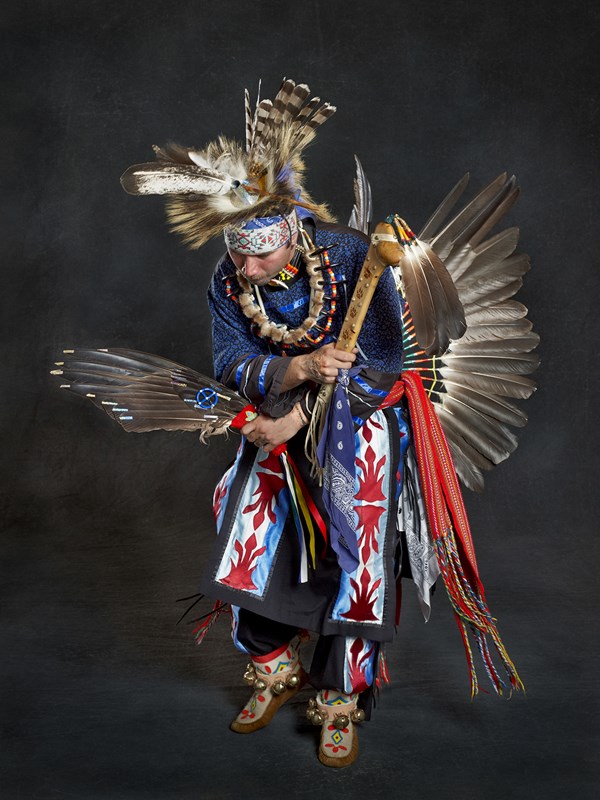 Hoogstraten’s project –– the photos, the book, and the exhibits –– did not come without an occasional setback.
Hoogstraten’s project –– the photos, the book, and the exhibits –– did not come without an occasional setback.
“I was shooting in Kansas in 2018 and the temperature was 105 degrees,” she said. “After I finished, I was given a cooler full of fresh sweet corn. When I got back to Chicago in my car, I realized that the cooler had leaked all over my laptop and onto many of the written statements that went with the photos. I let it all dry out for several days and luckily, I was able to restore all of it.”
Hoogstraten was born in Kalamazoo, Michigan and has now lived in Chicago for 45 years, a return of sorts to her tribal roots.
“My mother’s side of the family is from a farm on Potawatomi treaty land in Belvue, Kansas,” she said. “My Chicago ancestors, the Ouilmettes, left in 1838, at about the same time as the forced removal of the Indiana Potawatomis to the west.”
Archange Ouilmette and her family, lived in one of two permanent homes on the north side of the Chicago River, next to Jean Baptiste Pointe Du Sable, where the River North neighborhood stands today. Her namesake, the Village of Wilmette, is located on her former reserve of 1,280 acres.
It is clear that Hoogstraten, who identifies her role in this project as a visual storyteller, has gained new hope for the Potawatomis over the last decade. Her photos, which express both the pride and real joy of the participants, affirm that dream.
In the book she writes, “Presenting the faces, stories, and regalia of our Potawatomis will contribute to a better understanding of our transformed place in America and provide a road map to the future. For us, there will be no cultural loss defined by assimilation. Our children’s children will see the symbolism of our time, just as we look back at our ancestors. My objective is to create a compelling visual record that will become a permanent archive for our place on the timeline of Potawatomi history and American history.”
Now, visitors to this exhibit, located on the homeland of the Potawatomis, will be able to experience a bit of Skokie history as well. q
Dancing for Our Tribe: Potawatomi Tradition in the New Millennium
Skokie Heritage Museum, March 1–June 3
Hours: Thursdays, Fridays & Saturdays: 12–4 p.m.
Devonshire Cultural Center, March 1–May 5
Sundays: 8 a.m.–6 p.m./ Mondays-Thursdays: 9 a.m.–9 p.m. / Fridays: 9 a.m.–6 p.m. / Saturdays: 9 a.m.–4 p.m.
Opening Reception and Book Signing
Skokie Heritage Museum, Saturday, March 4, 2–4 p.m.
Purchase the book here.
